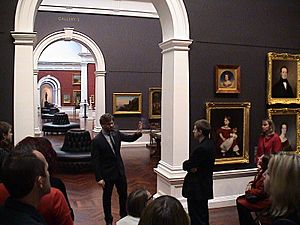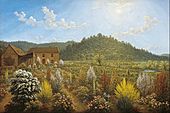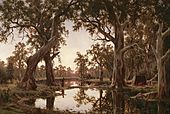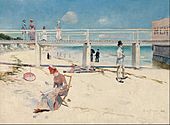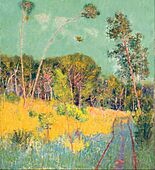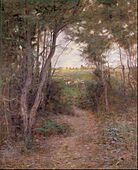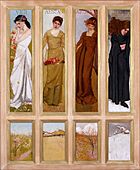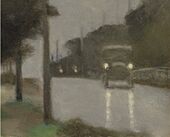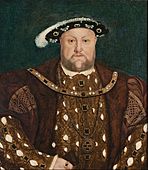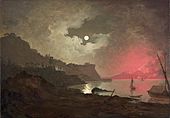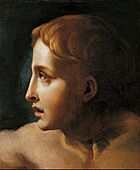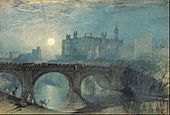Art Gallery of South Australia facts for kids
 |
|
| Established | 1881 |
|---|---|
| Location | North Terrace, Adelaide, Australia |
| Type | Art gallery |
| Visitors | 780,000 (2019) |
The Art Gallery of South Australia (AGSA) is a super cool art museum in Adelaide, Australia. It started way back in 1881. AGSA is the biggest art museum in South Australia. It has nearly 45,000 amazing artworks! This makes it the second-largest state art collection in Australia. You can find it on North Terrace, right next to the South Australian Museum and the University of Adelaide. Jason Smith became the director of AGSA in February 2025.
AGSA has a huge collection of Australian art, including art by Aboriginal and Torres Strait Islander artists. It also shows art from Europe, Asia, and North America. Every year, AGSA hosts a special festival called Tarnanthi, which celebrates contemporary Aboriginal and Torres Strait Islander art. The gallery also has many visiting exhibitions and sends art to other galleries around the region.
Contents
History of the Art Gallery
How the Gallery Started
The South Australian Society of Arts began in 1856. This group wanted a public art collection for everyone to enjoy. In 1880, the government gave money to start buying art. The National Gallery of South Australia opened in June 1881. It had 22 artworks bought from a big exhibition in Melbourne. Other artworks were lent by Queen Victoria and the British Government.
The gallery first opened in two rooms of the public library. Prince Albert Victor and Prince George officially opened it. In 1889, the art collection moved to the Jubilee Exhibition Building. It stayed there for ten years.
A very important event happened in 1897. Sir Thomas Elder passed away and left £25,000 to the art gallery. This money was specifically for buying more artworks. This gift was the first big donation to any art gallery in Australia.
The Gallery Buildings
Because of Sir Thomas Elder's generous gift, the government decided to build a special home for the art. This new building, now called the Elder Wing, was designed by C. E. Owen Smyth. It was built in a Classical Revival style and opened in 1900.
The building had a covered entrance at first. In 1936, it was updated and made bigger. This included a new front with an open Doric entrance. Over the years, the gallery has been expanded many times. Big additions were made in 1962, 1979, and 1996. These changes added more space for displaying art and for offices.
The gallery building is a special landmark. It is listed on the South Australian Heritage Register. Today, the building uses solar battery storage. This helps it use less electricity from the main power grid.
Who Runs the Gallery?
In 1939, a new law was made. This law separated the Art Gallery from the Public Library and Museum. The gallery got its own board to manage it. Its name was changed to the Art Gallery of South Australia.
From 1996 to 2018, a group called Arts SA helped manage the gallery. After that, the government's Department of the Premier and Cabinet took over.
Christopher Menz was the director until 2010. He left because he felt the government wasn't giving enough money to the gallery.
Nick Mitzevich became the director in July 2010. He had big plans for AGSA. He bought and commissioned many artworks that got people talking. For example, he showed a video artwork on the outside of the gallery during the Adelaide Fringe festival. He also bought 16 paintings by Ben Quilty for the gallery's 130th birthday.
Mitzevich also hung a sculpture of two headless horses from the ceiling. This artwork, called We Are All Flesh, got a lot of attention. His idea was to show modern art next to classic pieces. Many people thought he did a great job. Visitor numbers grew from 480,000 in 2010 to 800,000 when he left.
In April 2018, Mitzevich left to lead the National Gallery of Australia. After him, Rhana Devenport became the first female director of AGSA. She started in October 2018. Devenport announced in March 2024 that she would leave after six years.
In June 2024, Lisa Slade also left the gallery. She had been the assistant director for artistic programs. In February 2025, Jason Smith became the new director of AGSA. He had previously led other art galleries.
In June 2025, the Governor of South Australia, Frances Adamson, and her husband became the gallery's first patrons. They will help promote the gallery around Australia and the world.
Art Collection Highlights
As of May 2019, AGSA has almost 45,000 artworks. Only the National Gallery of Victoria has a larger collection among state galleries. About 512,000 people visit AGSA each year.
A large sculpture by Lindy Lee called "The Life of Stars" is outside the gallery. It is 6 meters tall. This shiny stainless steel sculpture reflects its surroundings during the day. At night, it glows with light from over 30,000 tiny holes. These holes look like a map of our galaxy. The gallery bought this sculpture in 2018 as a tribute to the departing director, Nick Mitzevich.
Australian Art Collection

The gallery is famous for its collection of Australian art. This includes art by Aboriginal people and art from the colonial period (around 1800 onwards). It has many artworks from the 1800s, like Australian Impressionist paintings. The collection also features many works by female artists from the 1900s. There is a large collection of art from South Australia, including 2,000 drawings by Hans Heysen.
Famous Australian paintings include A break away! by Tom Roberts. You can also see A holiday at Mentone by Charles Conder and Road to Templestowe by Arthur Streeton. Art from the mid-1900s includes works by Russell Drysdale and Sidney Nolan. South Australian artists like Jeffrey Smart are also featured.
AGSA was the first Australian gallery to buy art by an Indigenous artist in 1939. Today, the gallery has a large collection of both old and new Aboriginal and Torres Strait Islander art. This includes the Kulata Tjuta collaboration by Aṉangu artists.
International Art Collection
The gallery has many European landscape paintings. These include works by Jacob Isaakszoon van Ruisdael and Camille Pissarro. Other European artists like Goya are also represented.
There is a big collection of British art. This includes many Pre-Raphaelite artworks. Artists like Edward Burne-Jones and Dante Gabriel Rossetti are featured. You can also see Circe Invidiosa by John William Waterhouse. British portrait painters like Anthony van Dyck are also in the collection.
The sculpture collection includes works by famous artists like Rodin and Henry Moore.
The Asian art collection started in 1904. It includes art from all over Asia. There is a special focus on old Japanese art, art from Southeast Asia, India, and the Middle East. AGSA has Australia's only permanent display of Islamic art.
Exhibitions and Special Events
AGSA hosts the Adelaide Biennial of Australian Art. It also shows many visiting exhibitions each year. The gallery sends travelling exhibitions to other regional galleries.
Adelaide Biennial of Australian Art
The Adelaide Biennial is a special exhibition. It is the only major event focused only on modern Australian art. It is also the longest-running exhibition of its kind. The Biennial happens every two years. It is part of the Adelaide Festival. AGSA works with other places like the Samstag Museum and the Adelaide Botanic Garden for this event.
The Biennial started in 1990. It aimed to show off contemporary Australian art to a wider audience. Today, it still follows this vision. Each Biennial has a unique theme and a catchy title.
Past Biennial Events
- The 2014 Biennial was called "Dark Heart". It explored how national feelings were changing.
- In 2018, the theme was "Divided Worlds". It looked at differences between ideas, places, and communities. This exhibition attracted over 240,000 visitors.
- The 2020 Biennial was titled "Monster Theatres". It explored our connections with each other, nature, and technology. It featured paintings, photos, sculptures, and live performances. Due to the COVID-19 pandemic, some exhibits were shown online.
- The 2022 event was called Free/State. It was inspired by South Australia's history as a "free colony". It also explored ideas of freedom and different states of mind.
- The 2024 Biennial was called "No Such Thing as Gravity". It explored the unseen forces that shape our world.
Tarnanthi Festival
Since 2015, AGSA has hosted and supported Tarnanthi. This festival celebrates contemporary Aboriginal and Torres Strait Islander Art. The word Tarnanthi means "to come forth, appear, emerge" in the Kaurna language. In 2015, it was the biggest exhibition of Aboriginal and Torres Strait Islander art in the gallery's history. This city-wide festival happens every two years. In the years in between, there is a special focus exhibition at the gallery.
Sponsorship and Art Prizes
Diana Ramsay (1926–2017) and her husband James Ramsay (1923–1996) loved art. They gave a lot of money to the art gallery. Thanks to them, the gallery has bought over 100 artworks. These include paintings by Clarice Beckett and Camille Pissarro.
Diana started the Ramsay Art Prize in 2016. The James & Diana Ramsay Foundation continues their legacy. This foundation supports programs for children and families. Over 300,000 children and families have visited AGSA through these programs. In 2019, the couple left a huge gift of A$38 million to AGSA. This money is used to buy major artworks.
Ramsay Art Prize
The Ramsay Art Prize is a national art competition. It is for Australian artists under 40 years old. Artists can use any type of art medium. It is Australia's richest art prize, with a $100,000 award. The prize is given every two years. All the finalist artworks are shown in a big exhibition at the gallery. There is also a People's Choice Prize of $15,000, chosen by public vote.
Past Ramsay Art Prize Winners
- 2017: Sarah Contos won the main prize for her work Sarah Contos Presents: The Long Kiss Goodbye. Julie Fragar won the People's Choice Award.
- 2019: Vincent Namatjira won the main prize with his work Close Contact, 2018. Pierre Mukeba won the People's Choice Prize.
- 2021: South Australian artist Kate Bohunnis won for her moving sculpture edge of excess. Iranian photographer Hoda Afshar won the People's Choice Prize.
- 2023: South Australian artist Ida Sophia won with her video artwork witness. Zaachariaha Fielding won the People's Choice prize.
- 2025: Jack Ball won the prize for his large mixed media artwork Heavy Grit. The exhibition runs from May 31 to August 31, 2025.
Guildhouse Fellowship
The Guildhouse Fellowship also helps artists. It is for artists who are already established in their careers. The fellowship gives $35,000 to help artists research and create new work. These new artworks are then bought by the gallery.
Past winners include:
- 2019: Troy-Anthony Baylis
- 2020: Sera Waters, a textile artist
- 2021: Liam Fleming, a glass artist
- 2022: Tom Phillips, a painter
- 2023: Kyoko Hashimoto, a jewellery designer
- 2024: Michelle Nikou, a sculptor
Gallery
Selected Australian works
-
John Glover, A view of the artist's house and garden, in Mills Plains, Van Diemen's Land, 1835
-
H. J. Johnstone, Evening shadows, backwater of the Murray, South Australia, 1880
-
Florence Fuller, Mother and Child, c. 1890
-
Frederick McCubbin, A ti-tree glade, 1897
-
Clarice Beckett, Motor Lights, 1929
Selected international works
-
Hans Holbein the Younger (after), King Henry VIII, c. 1540
-
Joseph Wright of Derby, A view of Vesuvius from Posillipo, Naples, c. 1788
-
J. M. W. Turner, Alnwick Castle, 1829
-
John William Waterhouse, The Favorites of the Emperor Honorius, 1883
-
Camille Pissarro, Prairie à Éragny, 1886
-
John Collier, Priestess of Delphi, 1891
Getting There: Tram Stop
There is a tram stop right outside the gallery on North Terrace. This stop is on the BTANIC line of the Glenelg tram line. You can take the tram to the Adelaide Entertainment Centre.
| Preceding station | Adelaide Metro | Following station | ||
|---|---|---|---|---|
| Adelaide
towards Adelaide Entertainment Centre
|
Glenelg tram line | University
towards Botanic Gardens
|
||
See also
 In Spanish: Galería de Arte de Australia del Sur para niños
In Spanish: Galería de Arte de Australia del Sur para niños
- South Australian Living Artists Festival (SALA)
- South Australian Museum
- State Library of South Australia


